Want to rank on Google in 2025 but not sure if you should play it safe or fast?
That’s where the battle between PBN links and natural backlinks begins.
PBNs (Private Blog Networks) promise quick results by giving you full control over where and how your links appear. Natural backlinks, on the other hand, build trust over time by earning links from real websites that find your content valuable.
Each strategy has its pros and cons. One offers speed. The other offers safety.
In this article, you’ll learn how PBN and natural backlinks work, when each is worth using, and what risks to avoid. You’ll also see which one delivers better long-term SEO results.
Let’s break it down clearly, simply, and with real-world examples.
Whether you’re new to SEO or just looking for smarter strategies, this guide will help you make the right choice for your 2025 link-building plan.
What Are PBN Backlinks and How Do They Work?
A PBN, or Private Blog Network, is a group of websites that someone builds or controls to link back to their main site and improve its Google rankings. These links are not earned naturally. Instead, they are placed on purpose to pass SEO value and boost visibility.
Simple Example:

Suppose you run a website that sells fitness equipment. Instead of waiting for other websites to link to you, you buy a few expired domains that used to be fitness blogs. You put up some basic articles on each site. Inside those articles, you include links pointing to your main store using phrases like best home gym equipment. This is how a typical PBN link is created.
Want to learn more? Check out this guide on PBN links and how SEOs use them.
How PBNs Work
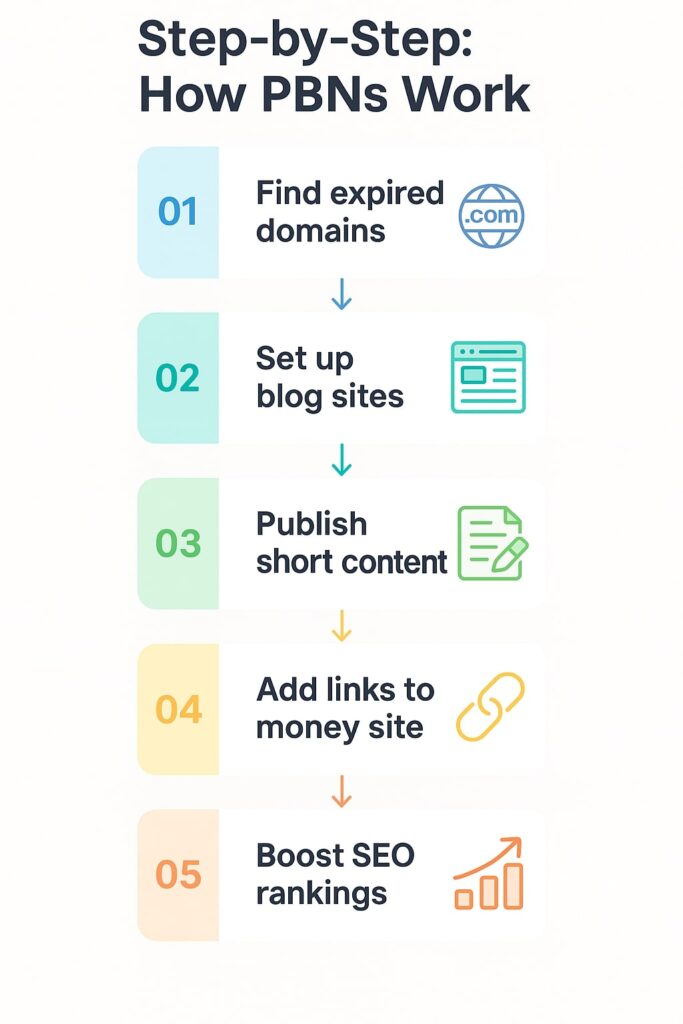
A PBN operates by linking multiple sites. These are usually owned or managed by one entity and are used to pass authority to a target site to improve rankings. These links are placed to help that main site rank higher on Google. The idea is to make it look like many independent sites trust your content, even though they are all part of your own network.
The process begins with finding expired or old websites. These are domains that used to be active and may still have links pointing to them. Because of those links, they hold some SEO value. SEOs look for these domains using tools or auctions.
Once the domains are bought, basic websites are set up. These sites are kept simple but made to look like real blogs. SEOs use different themes, hosting, and settings to avoid being detected by Google.
Content is then published on each site. The articles are short and contain a link to the main website. These links use keywords like best SEO software or cheap marketing tools. The content is not made for real readers. It’s added mainly to create backlinks.
These backlinks pass “link juice” to the main site. That can help improve search rankings. For many SEOs, this is a faster way to increase visibility compared to waiting for natural backlinks.
But there is a big risk. Google’s SpamBrain algorithm now detects signs that give PBNs away. This includes using the same hosting, repeated templates, or links that use the same words over and over. If Google finds a PBN, it may remove the network from search or penalize the main website.
To reduce the risk, smart SEOs use PBN management tools to track their network and avoid leaving patterns that Google can detect.
What Are Natural Backlinks and Why Do They Matter?
Natural backlinks are links you earn when other websites choose to reference your content because it’s helpful or trustworthy. These links are placed by real people. They are not paid for, requested, or manipulated.
In 2025, natural backlinks are one of the strongest signals for long-term SEO success. They show that your content has real value. Unlike PBN links, which are controlled by SEOs, natural links are placed voluntarily. That makes them safer and more trusted by Google.
These backlinks are especially important in competitive industries. If you’re in health, finance, SaaS, or other YMYL (Your Money or Your Life) niches, Google expects your links to come from trusted, relevant sources.
Key Traits of Natural Backlinks
- Editorial placement: Site owners or editors add your link because they believe it helps their audience. You don’t ask for it.
- Supports E-E-A-T: These links show Google that your site has Experience, Expertise, Authoritativeness, and Trustworthiness.
- Uses natural anchors: Anchors like this guide, visit the site, or brand names are common. They look organic, not forced.
Why They Matter in 2025
Natural backlinks are important because:
- They follow Google’s guidelines. This lowers the risk of penalties from SpamBrain or link spam updates.
- They come from trusted websites. This helps improve your site’s visibility and reputation in search results.
- They stay valuable over time. Unlike PBN links, natural backlinks often survive algorithm updates.
- They boost your brand’s image. Being mentioned on respected sites builds credibility in your niche.
Example
You publish a guide on remote team management. Later, a SaaS blog links to your article using the anchor this remote work strategy. That is a natural backlink. It was placed because the content was useful, not because you asked for it.
How to Earn Natural Backlinks
You can’t fully control who links to you. But you can increase your chances by doing the right things.
- Create high-quality, detailed content
- Write guest posts for trusted websites
- Use platforms like HARO to offer expert quotes
- Publish original research or case studies others want to cite.
Key Differences Between PBN and Natural Backlinks
The core difference between PBN and natural backlinks lies in how they are built. PBN links are manually created across a network of websites you control. Natural backlinks are earned when other websites choose to link to you based on content value.
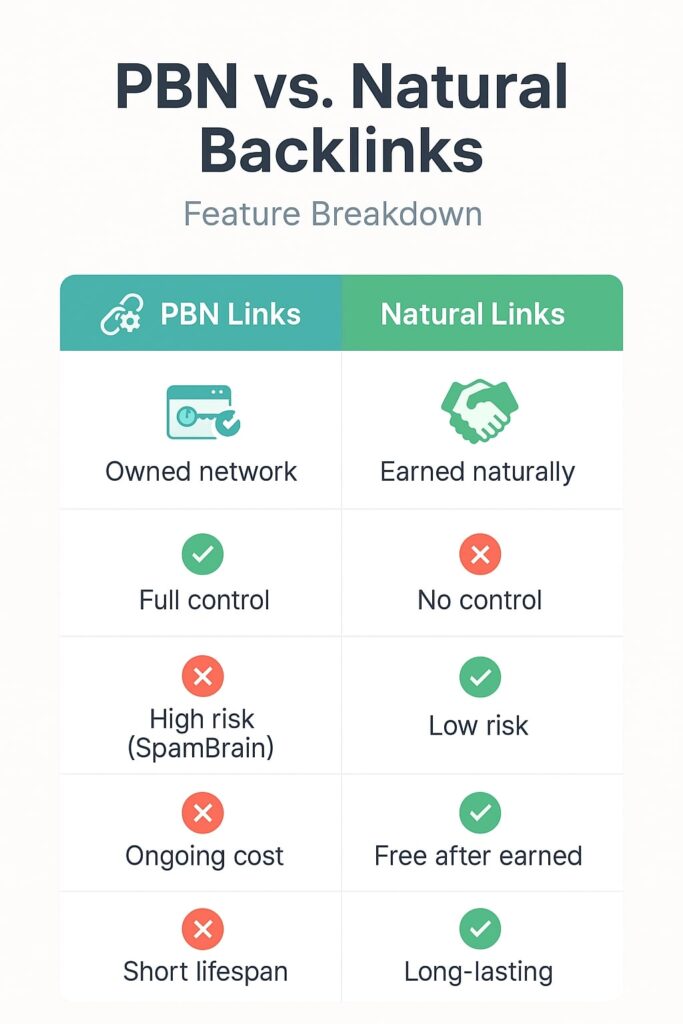
This affects everything from SEO trust to Google penalties. Here’s a breakdown of how they compare across major SEO factors:
PBN vs. Natural Backlinks Comparison
| Factor | PBN Backlinks | Natural Backlinks |
|---|---|---|
| Origin | Created from owned or rented websites | Earned from other websites based on content quality |
| Intent | To manipulate rankings by boosting link count | To share valuable information with users |
| Control | Full control over anchor text, placement, and timing | No control—links placed by others based on merit |
| SEO Impact | Short-term ranking boost, vulnerable to algorithm updates | Long-term growth, improves E-E-A-T and trust |
| Penalty Risk | High—violates Google’s guidelines and may trigger SpamBrain | Low—complies with Google’s rules and core updates |
| Cost | Lower upfront, but needs regular hosting, domains, and upkeep | Higher upfront (content, outreach), no hidden long-term costs |
| Longevity | Often short-lived; networks get devalued over time | Long-lasting, resilient through core updates |
| Ethical Standing | Considered black-hat SEO | Considered white-hat and future-proof |
Why This Difference Matters in 2025
In today’s SEO landscape, this difference is more important than ever:
- PBNs offer speed and control. You can launch a campaign fast and choose the exact anchor text. But they leave footprints, such as shared hosting or over-optimized patterns. That increases the risk of detection by SpamBrain or Penguin algorithms.
- Natural backlinks are slower but safer. They require real content, outreach, or PR to earn. But they build lasting authority and survive future algorithm changes.
Real-World Example
An SEO might build 20 sites using expired domains to link to their ecommerce store. This PBN strategy might work for a few months. But if Google detects shared infrastructure or low-value content, the rankings drop fast.
In contrast, a SaaS company that earns links from trusted blogs through original research or case studies sees steady growth. These links last for years and improve the site’s credibility.
Summary
PBNs give you full control but at a high risk. Natural backlinks take effort and time but bring lasting results. If you’re aiming for long-term SEO in a competitive space, natural backlinks are the better investment.
SEO Performance: Which Link Type Ranks Faster in 2025?
PBN backlinks often produce quicker ranking results, while natural backlinks take longer but deliver more stable performance over time.
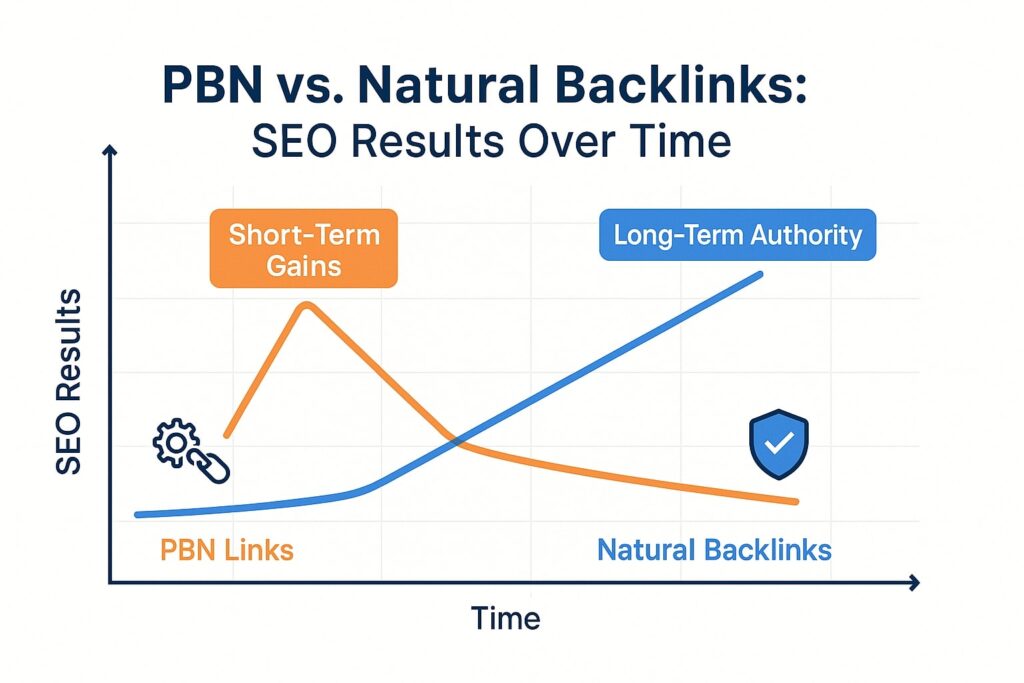
PBNs are favored for speed. Because you control the sites, link placement, and anchor text, you can influence rankings in a matter of weeks. For instance, some SEOs report using PBN links to boost visibility on new affiliate or niche sites in less than two months. However, this speed comes with high risk. If Google’s algorithms detect unnatural link patterns or footprints, the entire network or target site can be penalized.Despite the risks, PBN networks are still actively used, and many SEOs continue to see measurable results from them
Natural backlinks take longer to earn. They’re built through guest posts, digital PR, HARO, and helpful content that earns editorial mentions. A Surfer SEO case study demonstrated a 105% increase in organic traffic for a SaaS site within six months by securing just 15 high-quality natural backlinks from relevant blogs. These links held strong after major Google updates, contributing to long-term SEO growth and brand visibility.
Use cases depend on strategy:
- PBNs are useful for short-term tests, churn-and-burn projects, or ranking in low-competition niches.
- Natural backlinks are essential for building authority, especially in competitive industries like SaaS, finance, and health.
Key takeaway:
PBNs offer speed but come with high penalty risk. Natural backlinks require time and effort but provide lasting SEO value and algorithm resistance.
Which Offers Better ROI in 2025: PBNs or Natural Backlinks?
Natural backlinks provide higher long-term ROI than PBNs by delivering sustainable growth, stronger trust signals, and minimal penalty risk. PBNs may deliver quick wins, but the trade-off is a high chance of devaluation or penalties.
Why Natural Backlinks Outperform for ROI
Natural links are earned through valuable content, outreach, and genuine editorial interest. These links are:
- Trusted by Google: They follow search guidelines and contribute to your site’s Experience, Expertise, Authoritativeness, and Trustworthiness (E-E-A-T).
- Sustainable: Once earned, natural links keep passing authority without needing ongoing maintenance or reinvestment.
- Resilient to Updates: Natural links hold up in algorithm changes, including the March 2025 Core Update.
- Multi-Channel Benefits: They also bring referral traffic, brand exposure, and media coverage—adding to their SEO value.
SEO agencies consistently report long-term traffic growth from editorial links on trusted websites. These links drive results without penalty risks or repeated investment.
Why PBN ROI Is Often Short-Lived
PBNs appear cheaper and faster—but the long-term cost is higher:
- Penalty Risk: PBNs violate Google’s Webmaster Guidelines. If detected, rankings can drop or the site may be deindexed entirely.
- Reinvestment Cycle: When one network is penalized, SEOs must rebuild on new domains, repeat the hosting setup, and create fresh content.
- Limited Authority: Even strong expired domains often lack real organic traffic. Links from such sites don’t carry the weight of true editorial mentions.
Some SEO practitioners report early ranking improvements from s, but these gains often decline as search engines detect unnatural patternPBN campaigns or footprint similarities.
Final Take: Sustainable vs. Short-Term
Natural links take more effort to build—but the authority, traffic, and stability they provide make them a smarter long-term investment. PBNs may work for short sprints, but they rarely support lasting SEO success without risk.
For brands focused on organic growth, trust, and future-proofing rankings, investing in white-hat link building always delivers better ROI in 2025.
When Should You Use PBNs in 2025?
PBNs should only be used in 2025 when short-term SEO gains outweigh long-term risks. These networks can boost rankings quickly, but they violate Google’s guidelines and are increasingly detected by SpamBrain and link spam updates.
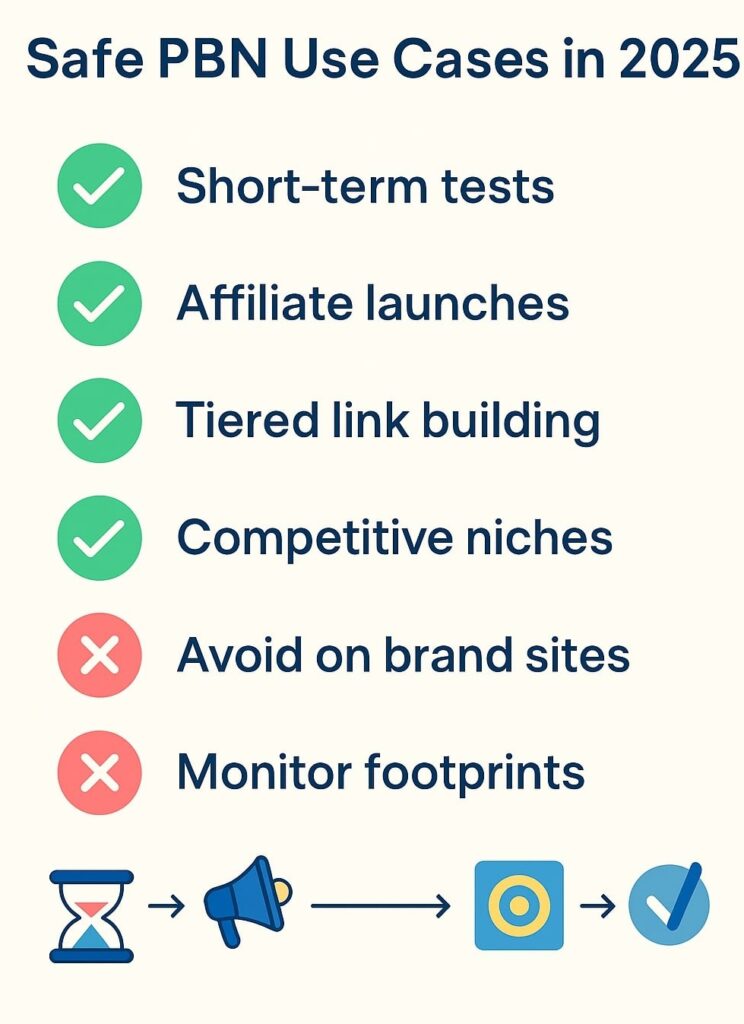
That said, a few scenarios may justify cautious use:
- Short-term SEO experiments: SEOs often use PBNs to test keyword ideas or content strategies without affecting core business sites.
- Time-limited campaigns: For seasonal product pages or affiliate launches, PBNs may provide a quick boost when the goal is immediate visibility.
- Highly competitive niches: In some markets, earning natural links is slow. PBNs may help match aggressive competitors who use similar tactics.
- Tiered link building: Some use PBN links to power up existing guest posts or niche edits, reducing direct risk to the money site.
However, the safety bar in 2025 is much higher:
- Use separate IP addresses and hosting providers to avoid leaving detectable footprints.
- Build high-quality, original content with natural formatting and outbound links.
- Rotate anchor text naturally and avoid over-optimization.
- Use dedicated tools to monitor, rotate, and secure your PBN network.
If you’re using PBNs today, consider tools like PBN management platforms to stay protected and reduce risk.
Bottom line: PBNs are no longer a shortcut to SEO success. They are expensive, risky, and only suitable for tightly controlled campaigns. For long-term growth, white-hat strategies with natural backlinks remain the smarter investment.
Need help building a safe, strategic backlink profile?
T-RANKS offers both well-managed PBN links and high-authority natural backlinks—tailored to your goals and risk tolerance.
Book a free link strategy call with T-RANKS to get started.
When Are Natural Backlinks Essential in 2025?
Natural backlinks are critical for sustainable SEO success in 2025. They signal trust, authority, and relevance, which search engines now value more than ever.
These links are essential in the following scenarios:
- YMYL Industries (Your Money or Your Life): In sectors like health, finance, and law, Google prioritizes Experience, Expertise, Authoritativeness, and Trustworthiness (E-E-A-T). Natural backlinks from credible domains are crucial to earn rankings safely.
- Competitive SaaS & B2B Niches: In software and enterprise spaces, backlinks from tech media or niche publishers are non-negotiable for long-term SEO visibility.
- Brand Authority Building: When your goal is trust and visibility, editorial backlinks show that your brand is respected.
Industry experts confirm that brand mentions from high-authority sources increase your presence in LLM-driven results like ChatGPT, Perplexity, and Google AI Overviews. These systems rely heavily on trusted citations and brand reputation. - Recovery From Penalties: Sites with past spammy link profiles must rebuild with clean, natural backlinks to restore domain trust.
- Consistent Organic Traffic Growth: Natural backlinks improve rankings, but they also bring qualified referral traffic. Visitors from reputable blogs or publications often convert better than cold traffic.
- Improving User Experience: Contextual links to your site help readers discover helpful, relevant content. This increases dwell time and signals quality to Google.
What makes a backlink “natural” in 2025?
- Topical relevance and niche alignment
- Editorial placement (not paid or manipulated)
- Descriptive, non-spammy anchor text
- Authority of the linking domain
- Link diversity (multiple referring sources)
Want to build natural backlinks that Google trusts?
T-RANKS delivers white-hat guest post links on real sites with strong editorial value and topic alignment—designed for long-term ranking growth.
Hybrid Link Strategy: Should You Combine PBNs and Natural Backlinks in 2025?
Yes, combining PBNs and natural backlinks can work in 2025, if implemented strategically. This hybrid approach balances the fast results of PBNs with the long-term trust of natural backlinks.
Experienced SEOs often blend both to gain short-term ranking boosts while building sustainable authority in the background.
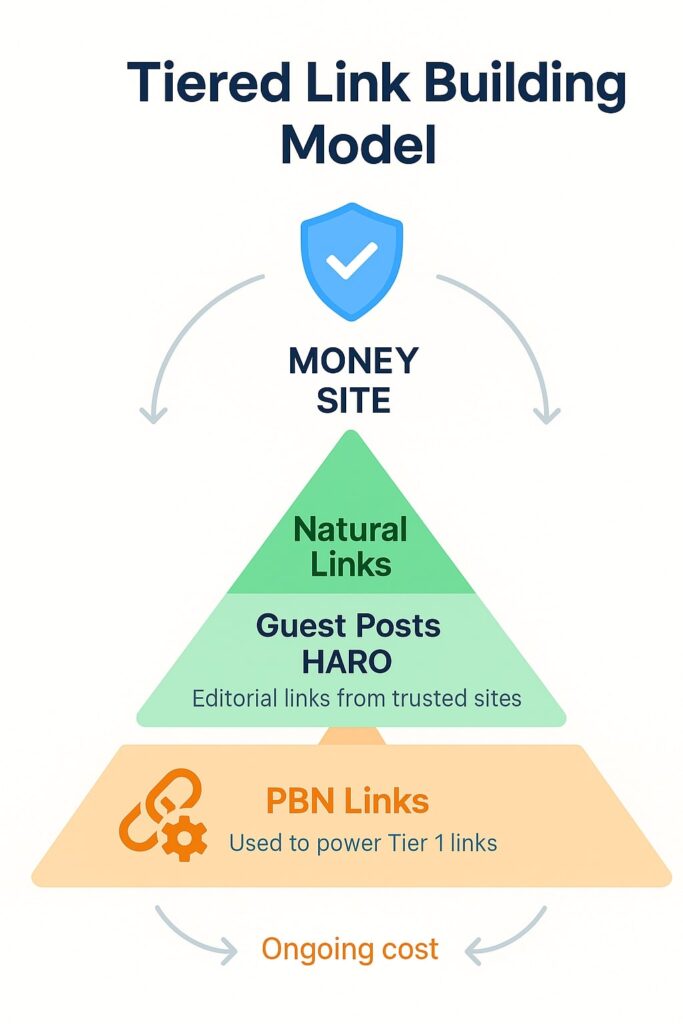
Why a Hybrid Strategy Works
Each link type plays a unique role:
- PBNs offer control and speed. You decide anchor text and link timing.
- Natural backlinks build credibility and long-term authority.
When used together strategically, PBN and natural links can form a more balanced and resilient link profile.. But the strategy should avoids patterns and obvious footprints.
Best Practice in 2025: Tiered Link Building Model
The most effective hybrid approach is using PBNs for Tier 2 and natural backlinks for Tier 1, structured as follows:
- Tier 1 Links:
High-quality, editorial links (guest posts, HARO, niche edits) pointing directly to your main pages. - Tier 2 Links:
PBNs used to power up those Tier 1 links—boosting their authority without directly touching your money pages.
This shields your core assets from risk while leveraging the ranking power of PBNs in the background.
When to Use This Strategy
- Launching New Pages: Get traction early by pointing PBNs to buffer pages (like guest posts) that already link to your site.
- Testing Anchors: Use PBNs to experiment with exact-match anchor performance on Tier 2 before applying them naturally.
- Competitive Niches: When link velocity matters, this strategy can simulate growth without overexposing commercial URLs.
Additional Guidelines
- Avoid footprint repetition: No shared IPs, hosting, or templates across PBN sites.
- Anchor text diversity is critical: Mix branded, partial-match, and generic phrases.
- Content quality must hold up: PBN posts should read like genuine articles, with original text and outbound authority links.
Conclusion
In conclusion, choosing between PBNs and natural backlinks in 2025 comes down to balancing speed, risk, and sustainability.PBNs can deliver quick results, but they require careful setup to avoid detection from evolving algorithms like SpamBrain.. Natural backlinks require more effort but provide long-term authority, trust, and resilience across Google updates.
A strategic blend—using PBNs for controlled traction and natural links for lasting credibility—can deliver the best outcomes when executed responsibly.
Need help executing a safe, ROI-driven backlink strategy? T-RANKS provides both trusted PBN solutions and white-hat link building to help you rank smartly in 2025.
Frequently Asked Questions (FAQs)
Do PBN backlinks still work in 2025?
Yes, PBN backlinks still work in 2025 especially when built with clean domains, quality content, and diverse anchors. They can boost rankings fast if managed properly and kept footprint-free.
Are natural backlinks better for long-term SEO success?
Yes, natural backlinks are ideal for long-term SEO growth. They align with Google’s guidelines and strengthen brand authority, but they take more time and effort to earn.
Can Google detect rented or poorly built PBNs?
Yes, Google’s SpamBrain system detects low-quality or obvious PBN setups, especially those with shared IPs or over-optimized anchors. But high-quality networks with unique signals remain harder to detect.
What happens if a PBN gets penalized?
If detected, links from penalized PBNs may be devalued or trigger ranking drops. However, if you isolate risk (e.g., use them in tiered linking), the impact on your main site can be minimized.
When should you consider using PBNs?
Use PBNs for fast results in controlled environments like test pages, local niches, or tiered link strategies. They’re not ideal for sensitive or brand-driven sites.
How do natural backlinks improve authority and trust?
Natural backlinks act as editorial votes from trusted sites. This signals relevance and authority to Google, improving E-E-A-T and rankings over time.
Is it smart to mix PBNs with natural links?
Yes, many SEOs use a hybrid strategy. Natural links go to core pages, while PBNs can boost secondary or tier 1 links—if used cautiously and ethically.
Are PBNs considered black hat SEO?
Technically yes, by Google’s definition. But many white-hat SEOs still use them with discretion, focusing on quality and safety to minimize risk.
Which type of backlink offers better ROI?
Natural links offer higher ROI long-term due to their stability and brand trust. PBNs can offer short-term ROI, but require ongoing effort to remain safe and effective.
Are all AI-generated backlinks risky?
Not necessarily. If the content is high-quality, reviewed, and placed on reputable sites, AI-assisted articles can still earn natural backlinks.
Is it legal to use PBNs?
Yes, using PBNs is legal. However, it may violate Google’s terms, which can affect your site’s rankings—but it’s not illegal in a legal sense.

